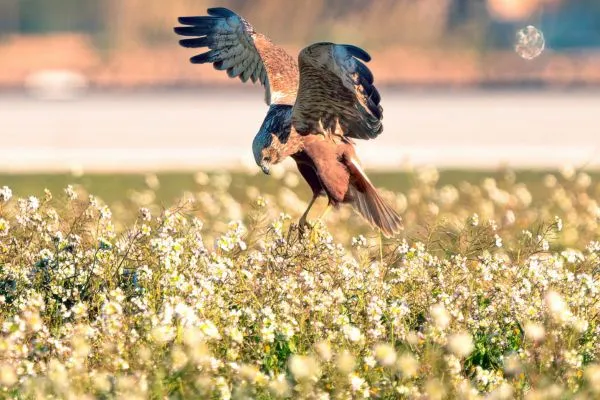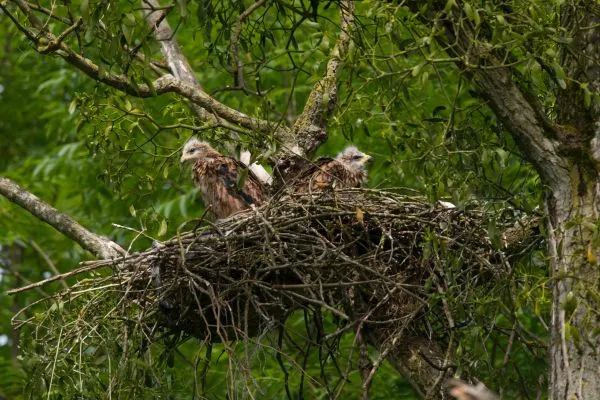Once virtually extinct in Britain, a magnificent bird of prey now thrives in British skies. What went so right?
Where do red kites live?
Kites will settle wherever carrion and trees are available – farmland, woodland, uplands and cities. Central England, Wales and Scotland are the best places to see them.
How to identify red kites

Male and female kites are very similar in size and appearance, but juveniles have a pale, ‘washed-out’ colouring.
Key features to help identify them include the sharp angles of long wings, tilting fine, forked tails and the intense autumnal fire of their feathers: fox reds and russets, winter-sunset orange, coal black, white ash; a marigold bill and feet and a cumulous blue-white head, nape and eye.
What is a red kite wingspan?
They have an impressive wingspan of almost two metres (175–195cm), which allows them to glide slowly above the ground, the white ‘wrists’ glowing visibly on the underside of chestnut, feather-fingered ‘hands’.
Why do red kites whistle?
They don’t really, but their call is a plaintive, slightly tuneless ‘peeeow’, like a child learning to whistle.
What do red kites eat?

Eating mainly carrion and worms, kites are opportunistic hunters that occasionally take small mammals.
Do red kites kill pigeons – and other wildlife?
With our inherent instinct to ‘control’ and manage wildlife, the kites’ return has led to some misrepresentation, misunderstanding and the mythologising of scare stories.
With incidents of children’s hands injured in lunchbox swoops, picnics ruined in Henley-Upon-Thames, chickens scooped from coops and stories of songbirds predated from hedges – has the reintroduction proved too successful?
Some of this behaviour (exacerbated by our own) is peak red kite and nothing new. In 1555, William Turner, the ‘father of zoology’, wrote to a naturalist friend (in translation): “We have Kites in England, the like of which I have seen nowhere else … more clamorous and greedier… for such is the audacity of our Kites, that they dare snatch bread from children, and fish from women.”
Kites were a bird of medieval townscapes, attracted by freely available food and waste. Emboldened by people feeding them in gardens now, kites (like chip-stealing gulls) are only doing what they have been invited to do. If they are not fed, they will disperse.
And what about wildlife, chickens, pets and other livestock? Confirmed carrion eaters, kites are rather fragile for their size. A dive into a hedge after nesting songbirds is neither effective nor possible. They are ‘weak-footed’ and surprisingly light, weighing only 1–1.2kg (2–3lbs). An average chicken weighs twice that.
As opportunists, they are capable of scooping up a chick exposed on open ground, a small bantam hen, a rabbit kit, a rat. But they cannot hold or kill anything that struggles too much, or is any heavier.

It is easy to misinterpret the behaviour or intention of such a large and impressive-looking raptor. Kites descend on lambing fields in spring – not for the lambs, but for the offerings of rubber banded, docked lambs tails, that fall off like little woolly snakes.
Where do red kites nest?

These large, untidy structures are set 12–20m up a tree and decorated with found objects, such as plastic, baler twine, toys and knickers stolen from washing lines.
What is the lifecycle of a red kite?

- Breeding Pairs bond for life and breeding begins at two years old.
- Two to three eggs can be laid around April in one brood, with fluffy white chicks hatching after approximately 28–30 days.
- These young chicks fledge at around 50–60 days after hatching. It takes about a month for fledglings to become fully independent.
- Some juveniles travel as far as Spain or Portugal in their first autumn, before settling back home near where they were born.
How long do red kites live?
The typical lifespan is four years, although they can live for over 25 years.
What is a group of red kites called?
Common collective names for a group of Red Kites include a 'wake', a 'roost', a 'husk', a 'soar' or a 'kettle'.
Discover more collective names for animals
What is the conservation status of red kites?
They remain listed under the highest protection, Schedule 1 of the Wildlife and Countryside Act.
What happened to red kites?
The 16th century brought food shortages and the Tudor vermin acts of Henry VIII and Elizabeth I, which demanded the culling of wildlife that might compete for ‘our’ food or spread disease.
Once ubiquitous across Britain, kites were easy targets – and a penny a head. With fines for non-compliance and agricultural wages at around four pence a day, the incentive was clear. London kites (and ravens) were, however, exempt, where their role in ridding the city of detritus and potential sources of disease was recognised.
The act wasn’t repealed until the mid-1800s, with the idea of vermin and vermin control well-established in the rural mindset.
The rise of Victorian pheasant shoots compounded the killing of much wildlife, including birds of prey, and as kites became ever rarer, they were targeted by egg collectors and taxidermists. By the 1870s, they were extinct in England and Scotland.
How were kites saved from the brink of extinction and reintroduced?
The Kite Committee formed in 1903 to protect the nests of the few remaining Welsh birds. But by the 1980s, it was clear the remnant population wasn’t going to spread or even survive.
In 1989, the RSPB, English Nature (now Natural England) and Scottish Natural Heritage (now Nature Scot) began a carefully considered reintroduction, and red kites from Sweden, Spain and Germany were reintroduced in England and Scotland, with the first chicks hatching in 1992.
How many red kites are there in the UK?
There are now nearly 4,500 breeding pairs, with birds even being reintroduced back to Spain, where numbers crashed in intervening years.
Did you know
Kite comes from the Old English ‘cyta,’ or ‘skut,’ to scoot or shoot, and the children’s toy kite took its name from the bird around the mid-1600s.
The red kite once had other names, too. ‘Puddock’, ‘puttock’ or ‘paddock’ crops up frequently in historic sources and may be a derivation of ‘poult hawk’, in the same way that polecat has come from ‘poule chat’, or ‘chicken cat’ – both referencing a penchant for poaching (possibly) hens, which, in the kite’s original day, would have been scratching around, and fed scraps, in the open.
Other red kite synonyms – ‘gled’, ‘glead’ or ‘glad’ – crop up in place names such as Gladsmuir, Gleadthorpe and Gledhill. Gilbert White confirms the name’s origin in his Natural History of Selborne (1789): “It is from [the kites’] gliding manner that they are still called in the north of England gleads, from the Saxon verb ‘glidan’, to glide.”
Find out more
Read our expert guide to birds of prey, and find out the difference between buzzards and kites, as well as why Hen harriers are on the brink of extinction in England.
